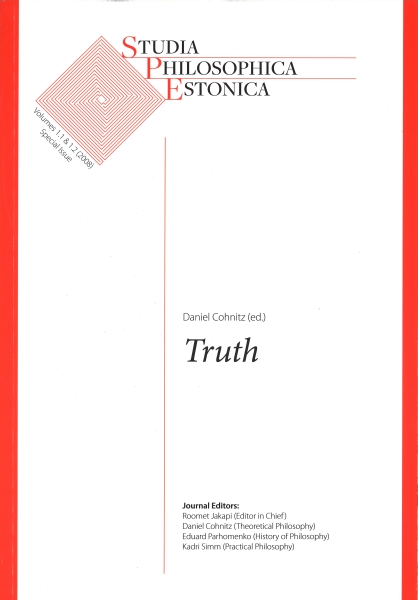Two-dimensional Truth
DOI:
https://doi.org/10.12697/spe.2008.1.2.04Keywords:
truth, two-dimensional semantics, possible worldsAbstract
The paper identifies two major strands of truth theories, ontological and epistemological ones, and argues that both are of equal primacy and find their home within two-dimensional semantics. Contrary to received views, it argues further that epistemological truth theories operate on Lewisian possible worlds and ontological truth theories on Wittgensteinian possible worlds and that both are mediated by the so-called epistemic-ontic map the further specification of which is of utmost philosophical importance.
Downloads
References
Armstrong, D.M. (1997). A World of States of Affairs, Cambridge University Press, Cambridge.
Chalmers, D.J. (2006). The foundations of two-dimensional semantics, in M.G. Carpintero and J. Macia (eds), Two-Dimensional Semantics, Clarendon Press,Oxford, pp.55-140.
Ellis, B. (1990). Truth and Objectivity, Blackwell, Oxford.
Engel, P. (2002). Truth, Acumen, Chesham.
Esfeld, M. (2001). Holism in Philosophy of Mind and Philosophy of Physics, Kluwer, Dordrecht.
Follesdal, D. (2005). Five questions to a formal philosopher, in V.F. Hendrcks and J. Symons (eds), Formal Philosophy. Aim, Scope, Direction, Automatic Press, pp.35-51.
Frege, G. (1892). Sinn und Bedeutung, Zeitschrift für Philosophie und Philosophische Kritik 100:25-50.
Haas-Spohn, U. (1995). Versteckte Indexikalität und subjektive Bedeutung, PhD thesis, Univesity of Tübingen, Berlin: Akademie-Verlag.
Haas-Spohn, U. and Spohn, W. (2001). Concepts are beliefs about essences, in A. Newen, U. Nortmann and R. Stuhlmann-Laeisz (eds), Building on Frege. New Essays on Sense, Content, and Concept,CSLI Publications, Stanford, pp.287-316.
Habermas, J. (1973). Wahrheitstheorien, in H.Fahrenbach (ed.), Wirklichkeit und Reflexion. Walter Schulz zum 60. Geburtstag, Neske, Pfullingen, pp.211-265.
Kant, I. (1781/87). Kritik der reinen Vernunft.
Kaplan, D. (1989). Demonstratives. An essay on the semantics, logic, metaphysics, and epistemology of demonstratives and other indexicals, in J.A. etal. (ed.), Themes from Kaplan, Oxford University Press, Oxford,pp.481-563. manuscript.
Künne, W. (2003). Conceptions of Truth, Oxford University Press, Oxford.
Kripke, S. A. (1972). Naming and necessity, in D. Davidson and G.Harman (eds), Semantics of Natural Language, Reidel, Dordrecht, pp.253-35 763-769.
Lewis, D. (1979). Attitudes De Dicto and De Se, Philosophical Review 88:513-543.
Lewis, D. (1980). Index, context, andcontent, in S. Kanger and S. Öhman (eds), Philosophy and Grammar, Reidel, Dordrecht, pp.79-100.
Lewis, D. (1986). On the Plurality of Worlds, Blackwell, Oxford.
Putnam, H. (1975). The meaning of ‘meaning’, Mind, Language and Reality. Philosophical Papers, Vol.II, Cambridge University Press, Cambridge, pp.215-271.
Putnam, H. (1983). Realism and Reason. Philosophical Papers, Vol. Cambridge University Press, Cambridge.
Rescher, N. (1973). The Coherence Theory of Truth, Oxford University Press, Oxford.
Spohn, W. (2008). Causation, Coherence, and Concepts. A Collection of Essays, Springer, Dordrecht.
Stalnaker, R.C. (1978). Assertion, in P. Cole (ed.), Syntax and Semantics, Vol.9 of Pragmatics, Academic Press, New York, pp.315-332.
Wittgenstein, L. (1922). Tractatus logico-philosophicus, Routledge & Kegan Paul, London.

